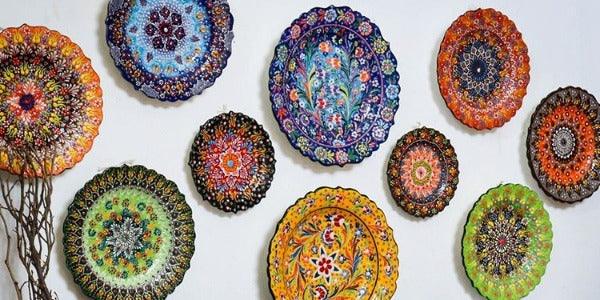The best way to achieve the desired originality in interior decoration is to subvert decorative and utilitarian elements by taking them out of their common places and uses. This is how dishes are when the style, material and history in which they are wrapped make them achieve the status of art, changing them from the supporting function of supporting gastronomy to being appreciated displayed under furniture or wall decoration .
Artifacts have always been important means of understanding the history, time and space they belonged to, after all, the aesthetics and raw material of domestic utensils are reflections of the political, economic and social scenario. Therefore, to understand the role of the plate in contemporary decoration, it is necessary to know its history as a material culture throughout the world.
And although crockery does not fully explain the social process, it makes us see the scenarios in which it was developed and transformed, as well as understand how aspects of society interfered in the constitution and function of the tableware.

The aesthetics of the decorative plates is a reflection of the scenario in which they are inserted.
The dishes are portraits of cultural exchanges and contextualized different moments in history to arrive at the informal or decorative setting we have today. For example, the traditional Chinese porcelain with cobalt blue paintings that crossed dynasties to serve the refinement of European banquets between the 16th and 18th centuries; or even the fine Portuguese earthenware that constituted the traditional artifacts of the Brazilian aristocracy until the 19th century.
In the 17th century, the concept of individual plates was developed, with flat plates replacing bowls , together with the improvement of cutlery. The individuality in the use of the artifacts was decisive for the elaboration of pieces with different formats such as those for soup, bread, dessert, tea and coffee (saucer) and salad.
Changes like this were also decisive in enhancing the decorative character of the tableware , even if not dissociated from the table, when using sets of handcrafted dishes to display economic power and social status at dinner parties.

The development of the use of utensils was decisive in enhancing the decorative character.
Raw materials, shapes, sizes, colors and painting techniques allow, among other characteristics related to culture, that the dishes assume the leading role in the environments, creating focal points such as composition with decorative arts such as masks , mandalas , plaques and mirrors forming galleries in the wall decoration ( gallery wall ).
With the help of stands for single plates , it is easier to highlight your favorite piece by placing it on sideboard furniture or gathering colored plates - following a pre-defined color palette - exploring different formats to decorate the wall, taking advantage of small spaces.
The key to maintaining the authenticity proposed by this decoration is to get away from everything that limits creativity, be it the formal sets or the symmetrical arrangement of the pieces, not being afraid to experiment with positions and benefit from the textures in plates of plain colors or with original artistic paintings such as those on Turkish pottery .

The combination of shapes, sizes and colors of the gallery wall dishes creates a focal point.
Decorative plates tell stories, are spectators of shared moments and lend their colors to insert cheer and welcome in the environment. And if there is anything to be learned from these decorative arts, it is that everything that enhances the feeling of coziness finds a prominent place in home decor.
Make the decorative plates from Arte & Tune the great transformation of your home!
Namaste!
Milene Sousa - Art & Tune












2 comments
Quero comprar, informar fone, grato
Esses pratos estão à venda? Qual o valor?